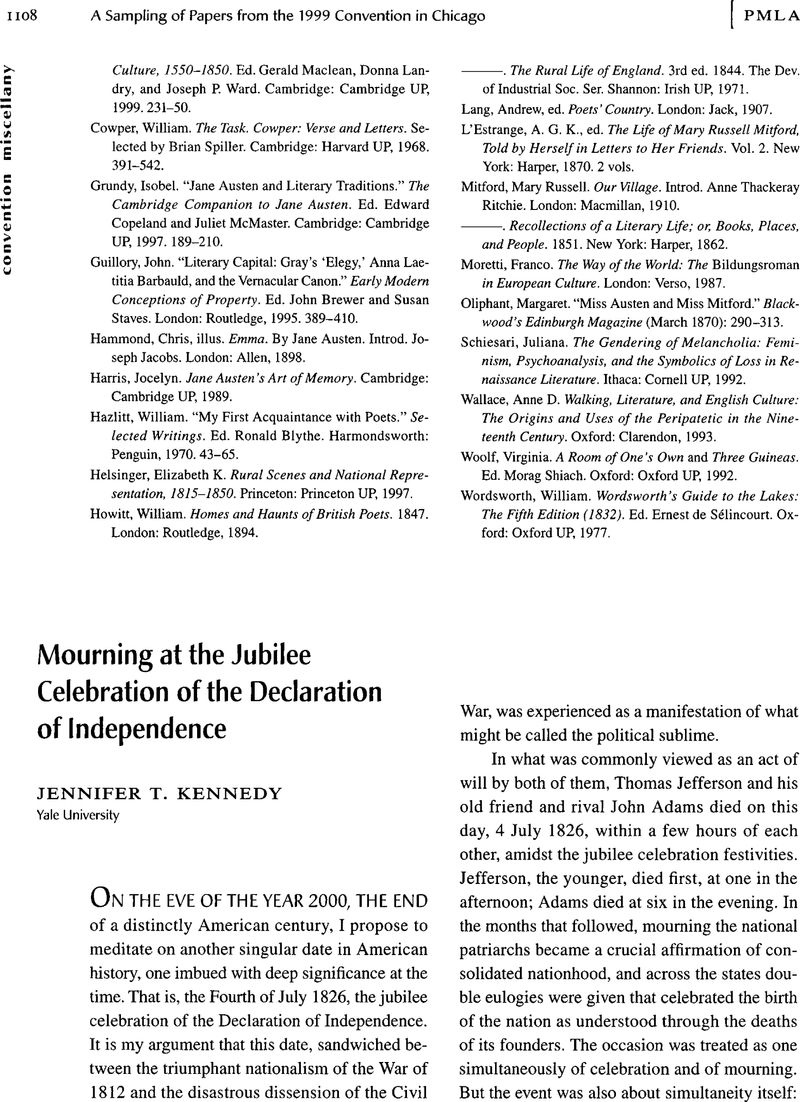Article contents
Mourning at the Jubilee Celebration of the Declaration of Independence
Published online by Cambridge University Press: 23 October 2020
Abstract

- Type
- Other
- Information
- Copyright
- Copyright © Modern Language Association of America, 2000
References
1 Benedict Anderson, Imagined Communities: Reflections on the Origin and Spread of Nationalism (London: Verso, 1991).
2 A Selection of Eulogies, Pronounced in the Several States, in Honor of Those Illustrious Patriots and Statesmen, John Adams and Thomas Jefferson (Hartford: Robinson, 1826) 259.
3 Michael Warner, “American Sermons,” New York Review of Books 1 Dec. 1999: 64.
4 L.H. Butterfield, “The Jubilee of Independence,” Virginia Magazine of History and Biography Apr. 1953: 124.
5 James Farrell and Stephen Browne have both provided detailed rhetorical analyses of Daniel Webster's famous eulogy for Jefferson and Adams that focus on Webster's concoction of an imaginary speech by Adams in defense of the Declaration of Independence at the Continental Congress. Although Farrell and Browne are chiefly concerned with Webster's rhetoric, their close reading of the eulogy demonstrates the extent to which the imagined speech serves the ideological purpose of promoting national unity in 1826. See Farrell's “The Speech Within: Trope and Performance in Daniel Webster's Eulogy to Adams and Jefferson,” in Thomas Benson, ed., Rhetoric and Political Culture in Nineteenth-Century America (East Lansing: Michigan State UP, 1997) 15–39, and Browne's “Webster's Eulogy and the Tropes of Public Memory” (Benson 39–47).
6 Mes Weekly Register 15 July 1826: 345.
7 Pauline Maier explains in American Scripture: Making the Declaration of Independence (New York: Vintage, 1997) that the published broadside included only John Hancock's signature as the president of Congress. “The Journals of the Second Continental Congress say only that on July 19, after New York's approval became known, Congress resolved ‘that the Declaration passed on the 4th, be fairly engrossd on parchment, with the title and stile of ”The unanimous declaration of the thirteen United States of America,“ and that the same, when engrossed, be signed by every member of Congress,’ and that on August 2 ‘the declaration of independence being engrossed and compared was signed,’ although some members added their signatures at later times” (151).
8 Maier 161.
9 The fact that Jefferson was accused of plagiarizing the declaration was also a factor in his insistence on the purity of the 4 July moment.
10 David Phillips, “The Birthday: Lifeline or Deadline?” Psychosomatic Medicine 54.5 (1992): 532–42.
11 Larzer Ziff, Writing in the New Nation (New Haven: Yale UP, 1991) 114.
12 Walter Benjamin, Illuminations (New York: Schocken, 1968) 93–94. I thank Shoshana Felman for drawing my attention to this passage.
- 1
- Cited by




